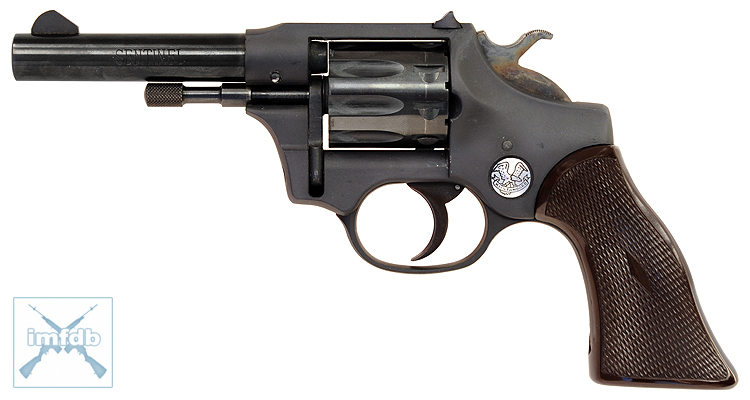
Family
Cookbook
Travel
Guns
Teach
Cartridges
Rifles
Handguns
Shotguns
Shooting Skills
Maintenance
General Information
Links
High Standard R-103

High Standard introduced their Sentinel revolver line in 1955, probably at the request of Sears Roebuck, which was a major customer and owned quite a bit of High Standard stock. Sears wanted a low-cost kit gun or “tackle box” revolver to sell under their J.C. Higgins brand. It was sold by Sears as the J.C. Higgins Model 88 . The J.C. Higgins guns were given distinctive grips, cylinder flutes, and cylinder release pins. Private label versions of the Sentinel were also made for Western Auto (the Revelation Model 99) and Armamex (Colonel Rex Applegate’s company in Mexico).
The Sentinel was a 9-shot .22 revolver. It was advertised to have an anodized aluminum frame, high-tensile carbon steel barrel and cylinder, single-stroke multiple ejection, a swing-out counterbored cylinder, a movable square-notched rear sight, a non- slip scored trigger, a diamond-checkered grip (though they didn’t mention it was plastic), and target accuracy.
The innovative design was completed by Harry Sefried, High Standard’s young design engineer, in a mere six months. Sefried wasn’t afraid to incorporate good ideas wherever he found them. The squared-off grip on the first model was modified from the Colt New Model .36 Pocket Pistol of 1862, and one shooter was said to remark that it was “the first decent grip on a revolver since the Civil War.” It remains to this day one of the most comfortable revolver grips I have ever encountered. The simplified cylinder lock design was taken from Hugo Borchardt’s experimental revolver of 1876, which he designed while working for Winchester and which was observed by Sefried during his own five years at Winchester. The gun, like the Broomhandle Mauser, is screwless but for the grip screw.
There is an integral
thumb rest molded into the frame behind the cylinder housing
on each side, making the gun feel quite natural in the
hand. The grip section and frame are die cast from
aluminum. There is no cylinder thumb release to
interrupt the smooth frame or complicate manufacture and
assembly. The gun can be broken down into four main
component groups: (1) the cylinder and crane, (2) the
trigger-guard/grip, (3) the barrel and frame assembly, and (4)
the hammer, trigger, and other lockwork components.
Everything is held together by the hammer pin, which runs
through both the trigger-guard/grip and the main frame.
Coil springs are used throughout.
Sefried designed a unique ratchet mechanism that utilizes nine holes drilled into the rear of the extractor, worked by a traditional pawl that extends from the frame. The holes give the pawl a positive interface, providing flawless cylinder rotation and reducing the machining necessary on the frame and cylinder. The design also reduces wear to the ratchet mechanism that eventually causes problems with more traditional designs. The nine-hole ratchet mechanism was abandoned in later-production Sentinels.
The Sentinel has an extended forcing cone that nearly eliminates lead shaving as the bullet enters the barrel. I hate it when a revolver spits hot lead out the side when I’m standing next to the shooter--it could be a fatal distraction in a fire fight.
The Sentinel was originally available in a so-called blued finish (which was actually a selenium black). The nickel finish was available in April of 1956. The early nickeled guns cost $5 or $6 more than the blued guns. The MSRP for the blued gun in 1955 was $37.50. The Sentinel had a one-piece wrap -around plastic grip. Originally the blue guns had a brown grip and the nickel guns had a white grip, but that scheme was not retained throughout production.
A 1955 catalog says the gun was available with a 3 or a 5 inch barrel. A parts list circa 1957 or 1958 shows 3 inch, 4 inch, and 2-3/8 inch barrels were available. By 1956, a 6 inch barrel was also available. The 3 inch barrel was dropped in 1964.
Sometime in the second half of the 50’s High Standard licensed the firm Armscor, a subsidiary of Squires Bingham & Co. in the Philippines, to manufacture the Sentinel. I do not know if they imported the parts from the U.S., though I suspect they did and the guns were simply assembled in the Philippines. These gun were not marked with an R-series number. Armscor called it the Model P and the right side of the gun was stamped with P followed by the serial number.
In 1957 a snub-nose model of the Sentinel was introduced, with a rounded butt on the grip. The early guns had a bobbed hammer, through about 1960, after which they featured a spur hammer. The blued version was Model #9144 and the nickeled version was Model #9145. Color finishes in gold (Model #9161), turquoise (Model #9162), and pink (Model #9163), known as Dura -Tone colors, were offered for the snub-barrel Sentinels. The Dura-Tone guns came in a deluxe presentation case and had white faux ivory grips. In 1967 when the R-108 series began the snub-nose models were given different model numbers, the blued one being Model #9344 and the nickeled one being Model #9345.
A snubby version was also made for Sears, labeled the J.C. Higgins Model 88 Fisherman, available in blue finish only with a one-piece brown plastic checkered grip and a ‘spur’ on the trigger guard.
The Western Auto snubby was labeled the Revelation Model 99, available in both blue and nickel finish. The early version with the one-piece grip has a ‘spur’ on the trigger guard, whereas the later version with the two-piece grip has a plain trigger guard
In 1958 a line of western-style revolvers was spun off the Sentinel line, the first model of which was called the Double-Nine. It was sold by Sears as the J.C. Higgins Ranger Model 90.
